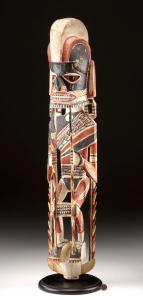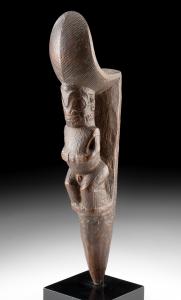Artemis Fine Arts reels in hefty $393K at auction of antiquities & tribal treasures from Santa Fe’s Ralph T. Coe Center
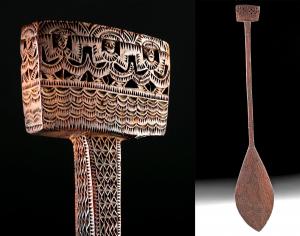
Circa 1820-1840 CE Austral Islands (Ra’ivavae) relief-carved ceremonial paddle. Sold for $18,000, more than seven times the high estimate
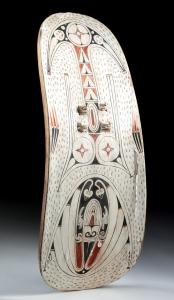
19th century Papua New Guinea Trobriand Islands Massim culture painted wood vayola (battle shield). Sold for $15,250 against an estimate of $3,000-$4,500
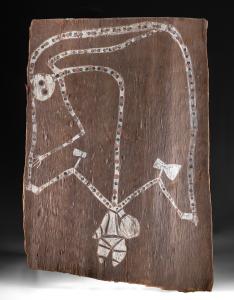
Northwest Arnhem Land (Australia, Northern Territory) bark painting of Namarrkon (Lightning Spirit). Sold for $14,500 against an estimate of $1,000-$1,800
Proceeds from the 380 lots consigned by the Coe will benefit the nonprofit’s Rehoming Program for repatriation and future care of cultural art
Bidding was as global in nature as the extraordinary pieces being auctioned. “The Coe Center’s collection is known throughout the world for its historically-significant artworks and tribal artifacts from North and Central America, Africa, Asia, New Zealand and other Pacific Island nations,” said Teresa Dodge, executive director of Artemis Fine Art. “Bidders were eager to acquire items that came directly from the Coe’s impeccably-documented collection.”
Many of the top lots achieved prices well beyond their auction estimates, especially prized tribal relics of Australasia and the South Pacific. A circa 1820-1840 CE Austral Islands (Ra’ivavae) relief-carved ceremonial paddle with an early-contact form led that group. The paddle was meticulously incised in relief with geometric motifs, including diamond grids, zigzag panels, concentric wave bands, and a procession of stylized human heads, possibly representing ancestral figures or spirit guardians. Described in the auction catalog as having “remarkable consistency and rhythm” in its design and execution, the 42.6-inch-long artwork sold for $18,000, more than seven times the high estimate.
A 19th century Papua New Guinea Trobriand Islands Massim culture painted wood vayola (battle shield) was distinctively decorated with abstract motifs in red and black paint. Vayola shields were deliberately designed to capture the enemy's attention in battle and signal the presence of the strongest and most courageous warriors on the battlefield. The auction example sold for $15,250 against an estimate of $3,000-$4,500.
From Northwest Arnhem Land (Australia, Northern Territory), a rare and early bark painting of Namarrkon (Lightning Spirit) dated to the early 20th century CE. Created with natural pigments on eucalyptus bark, the 39-inch-long by 27-inch-wide artwork attracted a flurry of bids, eventually settling at $14,500 against an estimate of $1,000-$1,800.
Another high-flier was a circa early-20th-century Malagan totok ancestor figure from Papua New Guinea / Tabar Islands of New Ireland (Melanesia). The 30.8-inch sculpture impressed with its openwork carving, red, black and white pigments; and inlaid shell eyes. Figures of this type were created for elaborate funerary rites and were regarded as tribal property. The auction example had a line of provenance that dated back to Cal Wilhelm Oberg, the Swedish owner of a copra (coconut) plantation in Tabar from 1920-1932. It sold for $11,500, more than six times the high estimate.
A remarkable 19th century Marquesas Islands (French Polynesia) tapuvae (ceremonial stilt step) was carved from dense hardwood and served a specific purpose. Rendering the appearance of an anthropomorphic tiki, the 16.25-inch artwork would have been affixed to a long wooden pole and worn during ritual or high-status stilt-walking performances. Against an estimate of $1,500-$2,500, it stepped up to a final bid of $9,750.
Rare and finely preserved, a circa 1830s CE New Ireland male kulap funerary figure was carved from soft chalk limestone with yellow and blue painted details, including simulated facial tattoos. The figure’s coiffure was carved to represent a textured cap. Such figures served as a temporary abode for the spirit of the deceased. The auction example from the Coe collection was part of a 2015-2016 exhibition at the Wheelwright Museum of the American Indian in Santa Fe. At Artemis’ sale, it reached the top of its estimate range, selling for $8,000.
A superb 18th-century CE Cook Islands ceremonial adze was designed with a triangular stone blade bound tightly to long wooden shaft with plaited sennit. It would have been an item of high prestige and was crafted by adze-making specialists who were known as ta’unga. Against an estimate of $1,200-$2,500, the coveted relic was bid to $5,750.
Three items from the Baule people of Ivory Coast put in a strong performance on auction day. A circa late 19th-century CE carved portrait mask with a crest and striations was of a type worn in solo dances during the final act of a masquerade known as “Mblo.” Carved from a single piece of hardwood, this particular example was personally regarded by Ralph Coe to be the finest Baule mask in his collection. It sold for $4,000 against an estimate of $1,500-$2,250. Also, a Kpan Pre mask from around the early 20th century CE was carved from single block of wood, exhibiting a pair of dramatic, rear-sweeping goat horns and distinctive facial features. The Kpan Pre appears as the third mask in the Baule Goli masquerade, which was performed during funerals of high-ranking community members and at major village gatherings. With a line of provenance that included a November 28, 1984 sale at Christie's New York, it landed within its estimate range at Artemis Fine Arts, realizing $3,500. A third Baule creation, a wooden heddle pulley depicting woman with scarification, was from the first quarter of the 20th century CE. It would have been used during the process of weaving narrow bands of cloth. Against an estimate of $800-$1,500, it sold for $3,750.
Yet another notable African entry was a Northeast Congolese Azande carved wooden figural staff from the late-19th to early 20th century CE. Formed as a slender tapering shaft surmounted by a stylized anthropomorphic head with an elongated, crest-like coiffure, this fascinating artwork sold for $8,000, nearly seven times its high estimate.
To contact Artemis Fine Arts about consigning ancient art, antiquities or cultural relics to a future auction, call Teresa Dodge at 720-890-7700 or email teresa@artemisfinearts.com.
Teresa Dodge
Artemis Fine Arts
+1 720-890-7700
email us here
Visit us on social media:
Facebook
YouTube
Legal Disclaimer:
EIN Presswire provides this news content "as is" without warranty of any kind. We do not accept any responsibility or liability for the accuracy, content, images, videos, licenses, completeness, legality, or reliability of the information contained in this article. If you have any complaints or copyright issues related to this article, kindly contact the author above.

